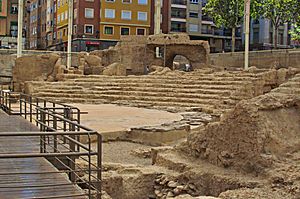Roman Theater (Zaragoza) facts for kids
|
Teatro romano de Zaragoza
|
|
 |
|
| Lua error in Module:Location_map at line 420: attempt to index field 'wikibase' (a nil value). | |
| Location | Zaragoza, Spain |
|---|---|
| Type | Roman theatre |
| Official name | Teatro romano |
| Type | Non-movable |
| Criteria | Monument |
| Reference no. | RI-51-0010689 |
Imagine a huge outdoor stage where thousands of people watched plays almost 2,000 years ago! That's what the Roman Theater of Zaragoza was. It's an ancient Roman theater located in what was once the Roman city of Caesaraugusta. Today, this city is known as Zaragoza, in Spain.
This amazing theater was built a long time ago, in the early 1st century AD. This was during the time of Roman Emperors Tiberius and Claudius. It was designed to look like the famous Theatre of Marcellus in Rome. The theater was a popular place for Roman plays and shows. It could hold about 6,000 people. This was a lot, especially since only about 18,000 people lived in the city back then! The theater was used for about 200 years. Then, its stones were taken to build other things. Today, it is in ruins, but you can still visit it. It's part of the Caesaraugusta Theater Museum.
Contents
History of the Roman Theater
The building of the Roman theater in Caesaraugusta started around the year 1 AD. This was when Emperor Tiberius ruled the Roman Empire. It was finished by the middle of the 1st century AD, under Emperor Claudius. This theater was very large, covering an area of 7,000 square meters. Its diameter was 106 meters across. This made it one of the biggest theaters in Roman Hispania (ancient Spain). About 6,000 people could sit and watch shows here. This was a huge number for a city of about 20,000 people.
How the Theater Was Built
Unlike some theaters built into hillsides, this one was built on flat ground. Builders used a special Roman concrete called 'opus caementicium'. The design copied the Theatre of Marcellus in Rome. It had many circular walls with other walls spreading out like spokes on a wheel. These walls supported the seating areas, called the cavea. The seats and the stage area, called the orchestra, were covered with beautiful marble.
The front of the theater was very grand. It was made of large, cut stone blocks in a style called 'opus quadratum'. This front wall stood three stories high, reaching 22 meters tall. The theater had a special entrance just for important people. This path went straight from the main door to the orchestra. It was used only by authorities to reach their special seats. This unique entrance is also seen in theaters in Turin and Minturno. But it was special for Roman theaters in Spain. This design might have allowed for many different kinds of performances.
From Ruins to Museum
The theater started to fall apart in the 3rd century AD. Its strong stones were taken and used to build the city walls. They were also used for other buildings. Because of this, only the Roman concrete structure is still visible today.
Over many centuries, the theater became completely buried. New buildings were built on top of it. It stayed hidden until the 1970s. That's when archaeologists started digging and found it again! After its rediscovery, the theater was carefully restored. Now, people can visit it and learn about its past. It is home to a museum that shows all the amazing things found during the digs.
Visitors can walk on special paths to see the old seating areas and the stage. A large, clear roof protects these ancient remains. Next to the ruins, there is a modern building. This building is the Interpretation Center. Here, you can learn about the theater's history. You can also discover the types of plays performed. It teaches about the social and political life of the Roman times.
Gallery
-
Drainage channel of the orchestra of the Roman Theater of Zaragoza (Caesaraugusta)
-
Central ramp for access to the orchestra
See also
 In Spanish: Teatro romano de Zaragoza para niños
In Spanish: Teatro romano de Zaragoza para niños
- List of Roman theatres
- List of Bienes de Interés Cultural in the Province of Zaragoza
- Caesaraugusta



























